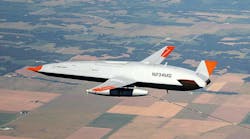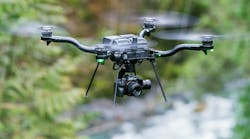by J.R. Wilson
BOARDMAN, Ore. — A new generation of small, long-range unmanned aerial vehicles (UAVs) took flight 20 June with the maiden voyage of the Scan Eagle, a joint development of The Insitu Group in Bingen, Wash., and Boeing's Unmanned Systems group in St. Louis.
In many ways, the Scan Eagle, based on Insitu's Seascan ship-based surveillance aircraft, is a miniature version of the U.S. Air Force Global Hawk, which made UAV history last year with a 22-hour, 7,500-mile flight from Edwards Air Force Base, Calif., to Royal Australian Air Force Base Edinburgh, South Australia.
While Global Hawk has the wingspan of a Boeing 737 jetliner and the length of a Learjet 24E business jet, the Scan Eagle is only four feet long, with a 10-foot wingspan. But it ultimately may have a range as long as 5,000 miles during a three-day flight at speeds as fast as 78 miles per hour.
It its first flight, the Scan Eagle launched from a pneumatic catapult at Insitu's eastern Oregon test facility and flew for 45 minutes at altitudes as high as 1,500 feet. It completed test points using the Global Positioning System and received real-time flight plan updates from its ground station. Retrieval involved Insitu's patented SkyHook technique in which the Scan Eagle snared a rope hanging from a 30-foot pole.
A pilot on the ground radio-controlled take-off and landing, while Scan Eagle's on-board computer autonomously controlled the rest of the flight. In an operational mode, the entire flight could be autonomous.
The test flight was the first in a 15-month agreement with Boeing and Insitu that began in February 2002. Evaluators based its operational performance on a 1998 demonstration by Insitu and the University of Washington, in which a 33-pound Seascan made the first UAV transatlantic flight — a 2,000-mile trip from Newfoundland to Scotland that used only 1.5 gallons of gasoline.
The Scan Eagle effort combines Insitu's aircraft with Boeing systems integration, communications, and payload technologies. "Our goal is to develop low-cost, long-endurance unmanned aerial vehicles offering a high degree of autonomy," Insitu founder and chairman Tad McGeer says.
"We are melding Insitu's expertise and unique capabilities with the best of Boeing to provide an autonomous, low-cost, long-endurance UAV for a wide range of potential customers," notes Charlie Guthrie, Boeing Unmanned Systems director of rapid prototyping and advanced concepts.
Potential applications include military reconnaissance, chemical weapons detection, severe weather monitoring, and border patrol. The aircraft can operate independently or in groups, as well as in an integrated team with other intelligence aircraft.
While neither Boeing nor Insitu has officially disclosed a price, published estimates put Scan Eagle's cost at less than $100,000 per aircraft. In military use, that would make it an inexpensive option for high-risk surveillance missions.


